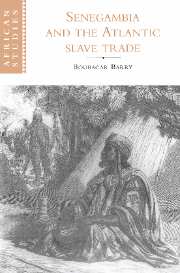Book contents
- Frontmatter
- Contents
- Preface
- Map
- I Senegambia from the fifteenth to the seventeenth century: a haven for incoming populations, a station for migrants on the move
- II Senegambia in the eighteenth century: the slave trade, ceddo regimes and Muslim revolutions
- III Senegambia in the first half of the nineteenth century: legitimate trade and sovereignty disputes
- 9 The crisis of the trans-Atlantic trading system and the triumph of legitimate trade in the first half of the nineteenth century
- 10 Popular rebellions and political and social crises in Futa Jallon
- 11 Futa Jallon expansion into the Southern Rivers region
- 12 The colony of Senegal and political and social crises in northern Senegambia
- 13 Defeat of the holy warriors in northern Senegambia
- IV Senegambia in the second half of the nineteenth century: colonial conquest and resistance movements
- Conclusion
- Notes
- Bibliography
- Index
- Other books in the series
10 - Popular rebellions and political and social crises in Futa Jallon
Published online by Cambridge University Press: 31 October 2009
- Frontmatter
- Contents
- Preface
- Map
- I Senegambia from the fifteenth to the seventeenth century: a haven for incoming populations, a station for migrants on the move
- II Senegambia in the eighteenth century: the slave trade, ceddo regimes and Muslim revolutions
- III Senegambia in the first half of the nineteenth century: legitimate trade and sovereignty disputes
- 9 The crisis of the trans-Atlantic trading system and the triumph of legitimate trade in the first half of the nineteenth century
- 10 Popular rebellions and political and social crises in Futa Jallon
- 11 Futa Jallon expansion into the Southern Rivers region
- 12 The colony of Senegal and political and social crises in northern Senegambia
- 13 Defeat of the holy warriors in northern Senegambia
- IV Senegambia in the second half of the nineteenth century: colonial conquest and resistance movements
- Conclusion
- Notes
- Bibliography
- Index
- Other books in the series
Summary
The parallel conduct of legitimate trade and contraband slave trading caused profound political, economic, and social transformations throughout southern Senegambia in the first half of the nineteenth century. The greatest change was the eruption of full-scale conflict between the powerful Muslim theocracy of Futa Jallon, internally weakened by a string of political, economic, and social crises, and the coastal states of the Southern Rivers, where legitimate trade, stimulated by peanut production, was developing. The decline of the slave trade shifted the trade balance between the two regions. The value of Futa Jallon's traditional market commodities was dropping. By contrast, the value of produce from the coastal states was now constantly rising, with peanuts proving particularly profitable. Smarting from the change in the balance of power, Futa Jallon, a landlocked power cordoned off behind the coastal states of the Southern Rivers, adopted a vigorous policy of territorial expansion, pushing coastward in an attempt to end the economic crisis brought about by the steady progress of legitimate trade. Futa Jallon's drive toward the conquest of the coast, apart from being designed to achieve control over legitimate trade in such produce as peanuts, was also linked to an internal political and social crisis. For new, centrifugal forces had emerged, forcing the old Futa Jallon aristocracy to react.
Throughout the nineteenth century the two royal clans, the Alfaya and the Soriya, had fought over central power at Timbo.
- Type
- Chapter
- Information
- Senegambia and the Atlantic Slave Trade , pp. 148 - 157Publisher: Cambridge University PressPrint publication year: 1997

